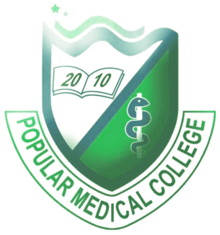Popular Medical College
Popular Medical College (PMC) (Bengali: পপুলার মেডিকেল কলেজ) is a private medical school in Bangladesh, established in 2010. It is located in Dhanmondi, Dhaka. It is affiliated with University of Dhaka as a constituent college.
পপুলার মেডিকেল কলেজ | |
 Logo of Popular Medical College | |
| Type | Medical College |
|---|---|
| Established | 2010 |
Academic affiliation | University of Dhaka |
| Chairman | Dr. Mustafizur Rahman |
| Principal | Prof Dr. T.I.M Abdullah Al Faruk |
| Location | , 23.7385°N 90.3797°E |
| Campus | Urban |
| Website | pmch-bd |
It offers a five-year course of study leading to a Bachelor of Medicine, Bachelor of Surgery (MBBS) degree. A one-year internship after graduation is compulsory for all graduates. The degree is recognised by the Bangladesh Medical and Dental Council.
History
Popular Group, a healthcare company in Bangladesh, established Popular Medical College in 2010.[1][2]
Campus
The college is located in Dhanmondi Thana, Dhaka.[1] The associated Popular Medical College Hospital lies 250 metres (820 ft) east of the college.
Organization and administration
The college is affiliated with Dhaka University as a constituent college.[1][3] The chairman of the college is Md. Mustafizur Rahman.[4] The principal is T.I.M. Abdullah Al Faruk.[5]
Academics
The college offers a five-year course of study, approved by the Bangladesh Medical and Dental Council (BMDC), leading to a Bachelor of Medicine, Bachelor of Surgery (MBBS) degree from Dhaka University. After passing the final professional examination, there is a compulsory one-year internship. The internship is a prerequisite for obtaining registration from the BMDC to practice medicine.[1][6] In October 2014, the Ministry of Health and Family Welfare capped admission and tuition fees at private medical colleges at 1,990,000 Bangladeshi taka (US$25,750 as of 2014) total for their five-year courses.[7]
Admission for Bangladeshis to the MBBS programmes at all medical colleges in Bangladesh (government and private) is conducted centrally by the Directorate General of Health Services (DGHS). It administers a written multiple choice question exam simultaneously throughout the country. Candidates are admitted based primarily on their score on this test, although grades at Secondary School Certificate (SSC) and Higher Secondary School Certificate (HSC) level also play a part. As of July 2014, the college is allowed to admit 75 students annually.[8]
References
- "Popular Medical College". World Directory of Medical Schools.
- "About Popular Group". Popular Pharmaceuticals. Retrieved 3 September 2015.
- "List of Constituent Colleges/Institutes under the University of Dhaka". University of Dhaka. Archived from the original on 30 August 2015. Retrieved 3 September 2015.
- "From Chairman's Desk". Popular Medical College. Archived from the original on 15 March 2014. Retrieved 3 September 2015.
- "Principal". Popular Medical College. Archived from the original on 18 March 2014. Retrieved 3 September 2015.
- "List of Recognized medical and dental colleges". Bangladesh Medical & Dental Council.
- "Govt to fix maximum fees". New Age. Dhaka. 27 October 2014. Retrieved 2 September 2015.
- "Health Bulletin 2014" (PDF). Bureau of Health Education (2nd ed.). Ministry of Health and Family Welfare. December 2014. p. 227. Retrieved 3 September 2015.